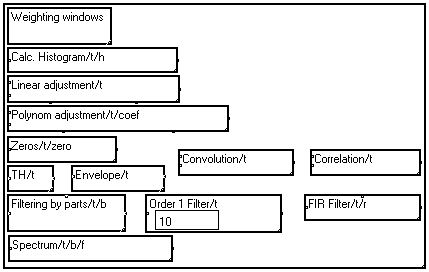
1. INTRODUCTION
1-1. MUSTIG : GENERAL PRESENTATION
1-1-1. Characteristics
MUSTIG is a signal analysis oriented language. It allows you to experiment with algorithms and is an excellent teaching tool. MUSTIG is :

Example of a simple dependence graph
The language provides easy interactive multi-dimensional signal analysis. It allows the user to easily plot an evolution graph according to parameters entered as additional dimensions. A complete library of operators is provided as basic building blocks and a partial list appears below.

Parts of the Library content
As far as signal analysis is concerned, these signals can be images (functions of two space variables) or sets of temporal signals like outputs of a network antenna (function of time and of one or two space variables).
Each "wire" of the description graph analysis propagates a signal S(u1, u2, …, uN) in which N represents the number of dimensions (or of variables) of the signal. The order N of the signal is between 0, for a constant, and some number (limited basically by the available memory). This order can change between a module input and output ; its identity can be changed as well : the Fourier transform changes time into frequency.
1-1-2. Application fields
- Demultiplexing and displaying of acquired data
- Smoothing of temporal series, regression lines.
- Integration, differentiation of signals.
- Non linear adjustment, least squares.
- Recursive, transverse filtering.
- Lattice filter.
- Filter gauging.
- Simulations with a set of coefficients in a form of series (like in a spread sheet)
- Generating binary sequences of maximal length.
- Spectral analysis of signals : weighting function FFT, ...
- Adaptive filters.
- Whitening of signal.
- Wiener filtering.
- Kalman filtering.
- Programming autoregressive methods (or maximum entropy methods).
- Antenna analysis, super-resolution.
- Image analysis
- …